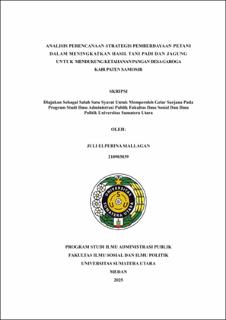| dc.description.abstract | Strategic planning at the village level plays a vital role in realizing targeted sectoral development, including in the agricultural sector. However, in Garoga Village, Samosir Regency, there is a misalignment between the RPJMDes (Village Medium-Term Development Plan) and the RKPDes (Village Government Work Plan), particularly in the implementation of farmer empowerment programs that are not yet comprehensive. This condition risks reducing the effectiveness of food security programs if not supported by a well-prepared, participatory, and data-based strategy. This study aims to analyze strategic planning within the RPJMDes and RKPDes that can empower farmers to improve rice and corn production in support of food security in Garoga Village. The main focus of this research is to assess how far village planning strategies respond to the real needs of farmers through well-targeted and sustainable programs.
This study uses Fred R. David’s strategic planning model, which includes: formulation of vision and mission, environmental analysis, long-term goal setting, and strategic evaluation. The research method employed is a qualitative approach, using data collection techniques such as interviews, observation, and documentation. Informants were selected through purposive and snowball sampling. Data validity was ensured through triangulation of sources and methods.
The results show that both the RPJMDes and RKPDes in Garoga have prioritized the agricultural sector, particularly rice and corn commodities. The vision and mission were formulated through participatory village meetings, and the environmental analysis revealed strengths such as farming experience and farmer group support. However, weaknesses were found in fertilizer distribution and lack of training. The village’s long-term goals include increasing production, strengthening farmer institutions, and developing agrotourism. Evaluation showed that farmer participation in monitoring remains low and not yet based on field data. The conclusion of this study indicates that strategic planning has begun to support farmer empowerment and food security, but improvements are still needed in the participatory and sustainable implementation and evaluation of programs. | en_US |


